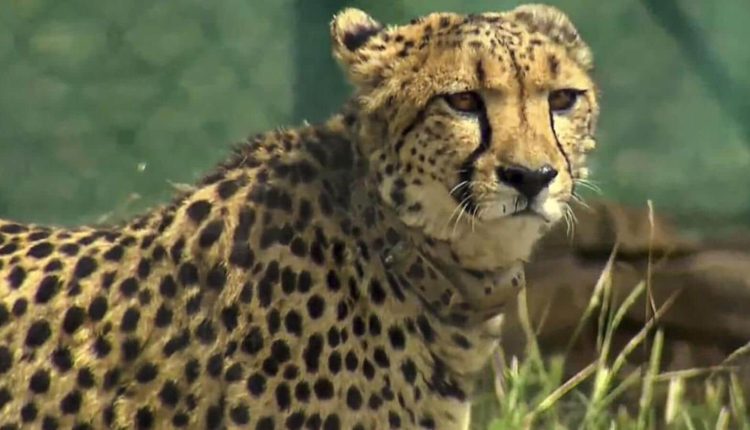BHOPAL: All the eight cheetahs translocated from Namibia to Kuno National Park in Sheopur district have been released from quarantine to a larger enclosure, officials said on Monday after releasing the last three female cheetahs.
Monday’s move successfully completes the first phase of inter-continental translocation project, officials of the Madhya Pradesh Forest department , Cheetah Task Force and Wildlife Institute of India (WII) said.
“Now cheetahs will adapt to the habitat by exploring the forest on their own in the 6 sqkm enclosure which is predator free and under security of high-resolution cameras and solar powered fencing of 12 feet (9 feet above the ground). They will kill the prey to feed themselves, said Uttam Kumar Sharma, field director Kuno National Park.
The cheetahs have been kept in separate internal compartments of the bigger enclosure to avoid a clash. The three cheetahs were put in a compartment spread across 8200 sq metre each. Two male cheetahs, Elton and Freddie, were released on November 5 and are living in one sq km compartment while the three female cheetahs were released into a 1.5 sq km compartment.
However, the experts and officials said they still have a long way to go because the bigger enclosure is just to make the cheetah familiar with habitat and prey base especially spotted deer and Nilgai, which are new for cheetahs.
First phase: transfer and quarantine
The cheetahs were located smaller enclosures after they reached the national park on September 17 where they were provided buffalo meat. A female cheetah Tablissi took time to get settle down and refused to eat the meat. Namibian experts Eli Walker and Barthelemy Bali then decided to go for meat of hare and chicken.
“The Cheetah Task Force decided to shift the male cheetahs but for female, we had to wait for 22 days due to leopard. On Saturday night, leopard used the path, which was created to relocate big cat naturally, and came out of bigger enclosure. On Sunday two female cheetahs and on Monday three female cheetahs were translocated sucessfully,” said Prakash Verma divisional forest officer, Sheopur.
The male cheetahs have acclimatized and have started hunting spotted deer. “Now, we are expecting this for female cheetahs too”, said the officer.
Preparations
“The cheetahs are safe and secure (in the bigger enclosure). Here the cheetahs will get familiar with some forest trees and prey base. For next three months, they don’t need to stay alert of wild animals especially leopards… There are more than 45 leopards in Kuno National Park,” added Uttam Kumar Sharma.
From appointment of new veterinarians, training of forest guards, sniffer dogs and monitoring technique, forest officials have now started preparations for the release of cheetahs in the wild.
On the recommendations of Cheetah Task Force (CTF), a three-member committee of veterinarians from Nanaji Deshmukh Veterinary Science University, Jabalpur has been formed to monitor the health of cheetahs in the bigger enclosure.
The cheetahs will be tracked by four high-resolution cameras in the enclosure but once they are in the wild, the forest guards will monitor them.
“A specialised training of forest guards is taking place. CCF’s Eli Walker are imparting training to trace cheetah in the wild with the help of satellite radio collar. From identification of cheetahs to assessing their health from distance, forest guards are being trained on all the aspects,” said Sharma.
Each cheetah will be monitored by two forest guards in the wild. A sniffer dog will also be deployed.
“An ITBP trained dog reached Kuno National Park for the security of cheetah and one dog, which is undergoing training, will be deployed in March,” said Sharma.
Challenges ahead
Experts said the real big challenge will be after their release in the wild.
“In the quarantine and bigger enclosure, the facilities were improved accordingly to help cheetahs in acclimatization but these facilities will not be available in the park. It won’t be easy for them to learn living in a new habitat. In the wild, cheetah will face new wild grass, weeds, thorny trees and other unknown vegetation,” said a senior officer of forest department.
Another challenge will be the presence of big cats. There are more than 45 leopards in the park and a tiger from Ranthambore is also roaming in the Chambal region.
A cat expert Anish Andheria said, “In the grass land, co-existence of cheetah with lion and leopard is possible as cheetah can run faster. It is impossible for cheetah to win in a fight. The only thing he can do is to escape the danger by running fast. But in mixed dry deciduous forest like Kuno National Park, leopard and tigers will have advantage.”
MP principal chief conservator of forest (wildlife) JS Chauhan said, “It is true that cheetahs will face many dangers but it is necessary for revival of cheetahs in India. They will face danger and will learn to fight it. This is a natural process of any translocation project.”
CCF founder and executive director Laurie Marker said, “We are pleased that the move of the cheetahs into the second stage has gone smoothly. The process continues to go well with the cheetahs hunting, and it looks like our carefully developed plans with the MP Forest Department are working well. It will be exciting to follow the cheetahs as they get back into hunting and living on their own as we move on to the next phase — release into the park.”
“Managing the eight cats while roaming freely in the park will be our next big challenge. But we will be ready for it,” said Marker.
However, there is some concern about the 12 cheetahs in South Africa that have been in quarantine for the past four months as the MoU to send 50 cheetahs in the next five years is yet ot be signed.
.


